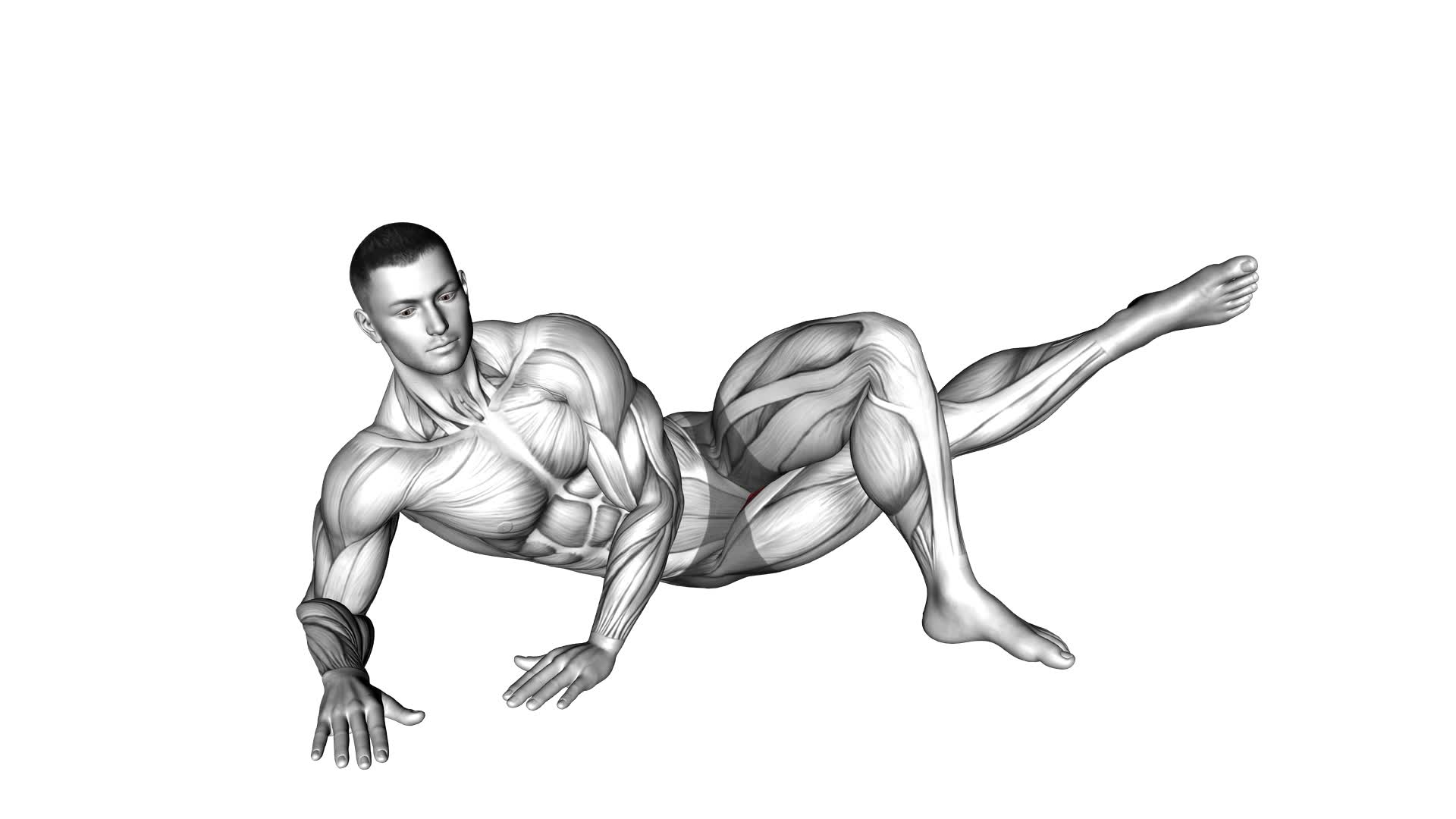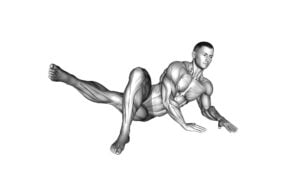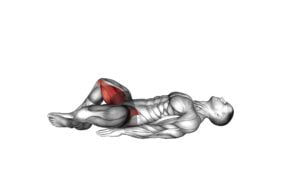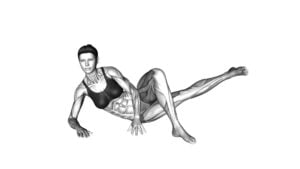Side Lying Hip Adduction (male) – Video Exercise Guide & Tips

Looking to strengthen your hip muscles? Get ready to try side lying hip adduction! This exercise targets your inner thighs and helps improve hip stability.
Watch This Exercise Video
In this video guide, we'll show you the proper technique and give you tips to maximize its effectiveness. Whether you're a beginner or more experienced, this exercise can be beneficial for everyone.
So grab a mat and get ready to work those hips!
Key Takeaways
- Side lying hip adduction targets the adductor muscles of the inner thighs.
- It improves hip stability and enhances balance.
- Performing side lying hip adduction reduces the risk of strains or sprains.
- By offering variations and modifications, side lying hip adduction can be tailored to different fitness levels and goals.
Benefits of Side Lying Hip Adduction
Improve your hip strength and stability with Side Lying Hip Adduction to enhance your overall athletic performance. This exercise offers numerous benefits that can help you in various aspects of your fitness journey.
First and foremost, Side Lying Hip Adduction targets the adductor muscles of your inner thighs, helping to strengthen and tone them. This can be particularly beneficial for athletes involved in sports that require lateral movements, such as basketball or soccer.
Additionally, this exercise helps to improve hip stability, which is crucial for maintaining proper form and preventing injuries during physical activities. By strengthening the muscles around your hips, you can enhance your balance and reduce the risk of strains or sprains.
Furthermore, Side Lying Hip Adduction offers variations that can be tailored to your specific fitness level and goals. You can increase the intensity of the exercise by using resistance bands or weights, or you can modify it by adjusting the range of motion.
Now that you understand the benefits of Side Lying Hip Adduction, let's move on to the equipment needed for this exercise.
Equipment Needed for Side Lying Hip Adduction
To perform Side Lying Hip Adduction, you'll need a few pieces of equipment. One essential piece of equipment is resistance bands. These bands provide the necessary resistance to strengthen and tone your hip adductor muscles during the exercise. Resistance bands come in different levels of resistance, so you can choose the one that suits your fitness level and goals.
In addition to resistance bands, you may also need some modifications depending on your individual needs. If you have difficulty lying on your side, you can use a mat or a folded towel to provide cushioning and support. This will make the exercise more comfortable and allow you to focus on the movement.
Furthermore, if you have any physical limitations or injuries, it's important to consult with a healthcare professional or a qualified fitness trainer. They can provide you with specific modifications or alternative exercises to ensure your safety and prevent any further injury.
Now that you know the equipment needed for Side Lying Hip Adduction, let's move on to the next section where we'll discuss the proper technique for performing this exercise.
Proper Technique for Side Lying Hip Adduction
To properly perform Side Lying Hip Adduction, you'll need to position yourself on your side and engage your hip adductor muscles by using the resistance bands and following the appropriate technique. Here are some important tips to ensure you're performing the exercise correctly:
- Maintain proper alignment: Lie on your side with your legs stacked on top of each other. Keep your body in a straight line from head to toe.
- Activate your core: Engage your abdominal muscles by drawing your belly button in towards your spine. This will help stabilize your body during the movement.
- Control the movement: Slowly bring your top leg across your body, towards the bottom leg, while keeping your hips stacked and maintaining control throughout the exercise. Avoid any jerking or swinging motions.
- Breathe: Inhale as you prepare for the movement, and exhale as you bring your leg back to the starting position.
Common modifications for Side Lying Hip Adduction include using a lighter resistance band or decreasing the range of motion. To progress the exercise, you can use a heavier resistance band or increase the range of motion by bringing your leg further across your body. Remember to listen to your body and choose the modification or progression that suits your fitness level.
Common Mistakes to Avoid During Side Lying Hip Adduction
Avoiding common mistakes is crucial when performing the Side Lying Hip Adduction exercise. To ensure you're getting the most out of this exercise and minimizing the risk of injury, it's important to be aware of the common mistakes and how to avoid them.
One common mistake is using momentum to lift your leg instead of relying on the strength of your hip muscles. It's important to maintain control throughout the movement and avoid swinging your leg up and down. Instead, focus on engaging your hip muscles to lift your leg in a slow and controlled manner.
Another mistake to avoid is lifting your leg too high or too low. The proper technique for side lying hip adduction is to lift your leg to just above hip level, keeping it in line with your body. Lifting your leg too high can put strain on your hip joint, while lifting it too low may not effectively target the hip muscles.
Lastly, be mindful of your body alignment during the exercise. Avoid rolling your hips forward or backward, as this can lead to improper muscle activation and potential strain on the lower back. Keep your body in a straight line from head to toe throughout the movement.
Tips for Maximizing the Effectiveness of Side Lying Hip Adduction
To further enhance the benefits of the side lying hip adduction exercise, it's important to consistently focus on proper form and engage your hip muscles throughout the movement. Here are some tips to maximize the effectiveness of this exercise:
- Gradually increase resistance: Start with a light resistance band and gradually increase the tension as your muscles get stronger. This will help you progress and continue challenging your hip muscles.
- Control the movement: Avoid using momentum or swinging your leg during the exercise. Instead, focus on slow and controlled movements to fully engage your hip muscles and ensure proper form.
- Add variations: Incorporate different variations of the side lying hip adduction to target specific areas of your hip muscles. You can try lifting your leg at different angles or using different equipment, such as ankle weights or a stability ball.
- Maintain proper alignment: Keep your body aligned throughout the exercise by ensuring that your hips, shoulders, and ankles are stacked on top of each other. This will help you maintain balance and target the correct muscles.
Frequently Asked Questions
How Long Should I Hold the Contraction During Side Lying Hip Adduction?
To get the optimal benefits from side lying hip adduction, it's important to hold the contraction for the right amount of time.
Proper form and technique are key to this exercise. The duration of the contraction depends on your fitness level and goals.
Start with holding the contraction for 2-3 seconds and gradually increase it to 5-10 seconds as you get stronger.
Remember to engage your core, keep your body aligned, and avoid any jerky movements for maximum effectiveness.
Can Side Lying Hip Adduction Help With Lower Back Pain?
Side lying hip adduction is an effective exercise for improving hip strength, which can help alleviate lower back pain. By targeting the muscles in your hips, this exercise promotes better stability and posture, ultimately reducing strain on your lower back.
Incorporating hip adduction exercises into your routine can strengthen your core and improve overall stability, leading to a healthier and pain-free lower back.
Are There Any Variations or Modifications for Side Lying Hip Adduction?
When it comes to side lying hip adduction, there are various variations and modifications you can try. These can help you customize the exercise to meet your specific needs or fitness level.
By incorporating different equipment, adjusting the range of motion, or adding resistance, you can make the exercise more challenging or target different muscles.
It's important to consult a professional or trainer to ensure proper form and safety when attempting these variations or modifications.
How Frequently Should I Perform Side Lying Hip Adduction to See Results?
To see results from side lying hip adduction, it's important to perform the exercise with the right frequency. The optimal contraction duration for side lying hip adduction varies, but a good starting point is to perform the exercise 2-3 times a week.
This will allow your muscles to recover and grow stronger. Remember to listen to your body and gradually increase the frequency as your strength improves.
Consistency is key for achieving results.
Is Side Lying Hip Adduction Suitable for Individuals With Hip or Knee Injuries?
Side lying hip adduction can be modified to suit individuals with hip or knee injuries. It's important to consult with a healthcare professional or a qualified trainer to determine the appropriate modifications for your condition.
Side lying hip adduction can provide several benefits, such as strengthening the hip muscles and improving stability. However, it's crucial to ensure that you perform the exercise correctly and within your comfort level to avoid further injury.
Conclusion
In conclusion, side lying hip adduction is a beneficial exercise for strengthening the hip muscles. By using proper technique and avoiding common mistakes, you can maximize the effectiveness of this exercise.
Remember to start with appropriate equipment and follow the recommended guidelines for a safe and efficient workout. Incorporating side lying hip adduction into your fitness routine can help improve hip stability and overall lower body strength.

Author
Years ago, the spark of my life’s passion ignited in my mind the moment I stepped into the local gym for the first time. The inaugural bead of perspiration, the initial endeavor, the very first surge of endorphins, and a sense of pride that washed over me post-workout marked the beginning of my deep-seated interest in strength sports, fitness, and sports nutrition. This very curiosity blossomed rapidly into a profound fascination, propelling me to earn a Master’s degree in Physical Education from the Academy of Physical Education in Krakow, followed by a Sports Manager diploma from the Jagiellonian University. My journey of growth led me to gain more specialized qualifications, such as being a certified personal trainer with a focus on sports dietetics, a lifeguard, and an instructor for wellness and corrective gymnastics. Theoretical knowledge paired seamlessly with practical experience, reinforcing my belief that the transformation of individuals under my guidance was also a reflection of my personal growth. This belief holds true even today. Each day, I strive to push the boundaries and explore new realms. These realms gently elevate me to greater heights. The unique combination of passion for my field and the continuous quest for growth fuels my drive to break new ground.







